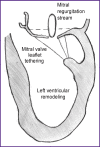Modified Mitral Valve Repair with Its Insufficiency of Ischemic Genesis
- PMID: 34513078
- PMCID: PMC8353715
- DOI: 10.17691/stm2021.13.2.07
Modified Mitral Valve Repair with Its Insufficiency of Ischemic Genesis
Abstract
The aim of the study was to assess the effectiveness of modified mitral valve repair in comparison with traditional methods of correcting ischemic mitral regurgitation.
Materials and methods: The results of surgical treatment of 80 patients with coronary artery disease complicated by ischemic mitral regurgitation were analyzed. The mean age of the patients was 58.95±8.36 years; the ratio of men and women was 67:13. Heart failure of FC II (according to the NYHA classification) was detected in 6 patients (7.50%), FC III - in 69 (86.25%) patients, FC IV - in 5 (6.25%) patients.Echocardiographic examination was used to determine the significance and genesis of mitral regurgitation in the preoperative period. 57 patients (71.25%) were detected with grade II mitral regurgitation, 23 (28.75%) had grade III.Annuloplasty was chosen as the operation for the correction of the valve apparatus. The patients of group 1 (n=23) underwent reconstructive surgery on the mitral valve using an autopericardial strip according to the technique, which we have developed, in combination with coronary artery bypass grafting (CABG), the patients of group 2 (n=26) underwent plastic surgery using a support ring in combination with CABG, patients of group 3 (n=31) had myocardial revascularization without correction of the valve apparatus.
Results: The patients of group 2 underwent restrictive mitral annuloplasty performed with rigid support rings, group 1 - with an autopericardial strip as a soft support ring, the patients of group 3 underwent CABG alone.One patient from group 2 died in the early postoperative period due to acute perioperative myocardial infarction.The most common complications were pleurisy, acute cardiovascular failure, acute respiratory failure, and cardiac arrhythmias. The smallest number of complications was noted in the group 3, where patients underwent CABG alone. After surgery, all the patients showed a decrease in mitral regurgitation, which was most pronounced in the groups with annuloplasty.When analyzing the immediate results of the operations, it was revealed that the patients of groups 1 and 2, who underwent combined interventions, had a higher percentage of complications, and the length of their stay in the ICU increased. However, these groups showed a significant improvement in mitral valve functioning. Plasty of the mitral valve with an autopericardial strip according to the technique, which we have developed, demonstrated a good hemodynamic effect, the absence of significant regurgitation in the postoperative period.
Keywords: coronary artery disease; ischemic mitral regurgitation; mitral valve reconstruction.
Conflict of interest statement
Conflict of interest. There is no conflict of interest among the authors and other interested parties.
Figures





References
-
- Nishimura R.A., Otto C.M., Bonow R.O., Carabello B.A., Erwin J.P. III, Guyton R.A., O’Gara P.T., Ruiz C.E., Skubas N.J., Sorajja P., Sundt T.M. III, Thomas J.D. American College of Cardiology/American Heart Association Task Force on Practice Guidelines. 2014 AHA/ACC guideline for the management of patients with valvular heart disease: executive summary: a report of the American College of Cardiology/American Heart Association Task Force on Practice Guidelines. J Am Coll Cardiol. 2014;63(22):2438–2488. doi: 10.1016/j.jacc.2014.02.537. - DOI - PubMed
-
- Vahanian A., Alfieri O., Andreotti F., Antunes M.J., Barón-Esquivias G., Baumgartner H., Borger M.A., Carrel T.P., De Bonis M., Evangelista A., Falk V., Lung B., Lancellotti P., Pierard L., Price S., Schäfers H.J., Schuler G., Stepinska J., Swedberg K., Takkenberg J., Von Oppell U.O., Windecker S., Zamorano J.L., Zembala M. ESC Committee for Practice Guidelines (CPG); Joint Task Force on the Management of Valvular Heart Disease of the European Society of Cardiology (ESC); European Association for Cardio-Thoracic Surgery (EACTS). Guidelines on the management of valvular heart disease (version 2012): the Joint Task Force on the Management of Valvular Heart Disease of the European Society of Cardiology (ESC) and the European Association for Cardio-Thoracic Surgery (EACTS). Eur J Cardiothorac Surg. 2012;42(4):S1–S44. doi: 10.1093/ejcts/ezs455. - DOI - PubMed
-
- Bokeriya L.A., Skopin I.I., Mironenko V.A. Khirurgicheskoe lechenie ishemicheskoy mitral’noy nedostatochnosti. 2003. pp. 4–151. [Surgical treatment of ischemic mitral regurgitation]. Moscow: Izdatel’stvo NTsSSKh im. A.N. Bakuleva RAMN.
-
- Carpentier A. Cardiac valve surgery: the “French correction”. J Thorac Cardiovasc Surg. 1983;86(3):323–337. - PubMed
-
- Vavilov A.V., Scopin I.I. Pathogenesis, diagnosis and surgical treatment of ischemic mitral regurgitation. Grudnaya i serdechno-sosudistaya khirurgiya. 2018;60(3):185–192. doi: 10.24022/0236-2791-2018-60-3-185-193. - DOI
MeSH terms
LinkOut - more resources
Full Text Sources
